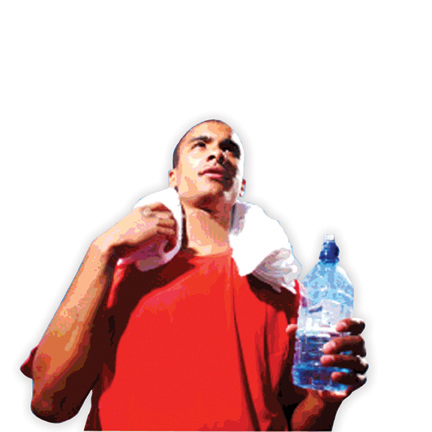The Centers for Disease Control reported that heat illness was a leading cause of death and disability of high school athletes from 2005-2009. Fortunately, heat illness is 100 percent preventable with the appropriate knowledge and procedures in place. While about 70 percent of high school athletes who suffer from heat illness are football players, girls volleyball and girls soccer are second and third respectively. As athletes and coaches prepare for fall season sports, it is critical for all to understand the different types of heat illness, how to treat these types of heat illness, and most importantly, how to prevent heat illness.
It is important to clarify the different conditions that encompass heat illness, some of which are life-threatening. The primarily heat-illness conditions include muscle cramps, heat syncope, heat exhaustion and heat stroke. The challenge in determining the difference between heat syncope, heat exhaustion and heat stroke is in measuring core body temperature. Unfortunately, oral, tympanic (ear) and axillary (armpit) measures of temperature are inaccurate in measuring core body temperature. Research has found that rectal temperatures are the most accurate method of measuring core body temperature. Because measuring rectal temperature is not feasible in many cases, it is best to contact someone on site who is in charge of the health care of the athletes (e.g., certified athletic trainer) or call 911 to ensure proper care when suspecting heat exhaustion or heat stroke. Some athletes do not progress through the different types of heat illness. In fact, the first time it is noticeable that the athlete has heat illness might be when they have heat stroke and in an emergency situation.
Heat Illness and Treatments
- Heat cramps are defined as an involuntary muscle contraction that is typically caused by dehydration, electrolyte imbalances, neuromuscular fatigue or a combination of these factors
- Treatment: Stop activity, re-hydrate with sodium-containing fluids and begin mild stretching
- Heat syncope (fainting) typically occurs after standing for long periods of time, immediately after activity or after rapid assumption of upright posture after resting or being seated
- Treatment: If core temperature is below 104, move the athlete to a shaded area, monitor vital signs, elevate the legs above the level of the head and rehydrate
- Heat exhaustion is typically defined as a core body temperature above normal and below 104 degrees Fahrenheit. Signs and symptoms include weakness, fainting, dizziness, headache, hyperventilation and nausea
- Treatment: Remove his or her excess clothing to increase the evaporative surface and to facilitate cooling. Cool the athlete with fans, ice towels or ice bags, remove the athlete to a cool or shaded environment (if possible) start fluid replacement (if possible)
- Heat stroke is defined as a core body temperature above 104 degrees. This is a life-threatening emergency and can be fatal unless promptly recognized and treated
- Treatment: Activate emergency response (911), remove clothes and equipment and immerse the body (trunk and extremities) into a pool or tub of cold water (approximately 35-60 degrees).
Prevention
There are two primary methods of preventing heat illness: acclimatization and hydration. Acclimatization is the process of an athlete preparing to perform at high levels in the heat. According to the consensus statement for heat acclimatization for secondary school athletes, there are eight main recommendations to prevent heat illness:
- There should be a 14-day heat acclimatization period prior to full-scale athletic participation.
- During the first five days, athletes should not participate in more than one practice per day.
- If a practice is interrupted by inclement weather or heat restrictions, the practice should recommence once conditions are deemed safe, but total practice time should not exceed three hours per day.
- A one-hour maximum walk-through is permitted during the first five days of the heat-acclimatization period; however, a three-hour recovery period should be inserted between the practice and walk-through (or vice versa.)
- During the first two days of the heat-acclimatization period, in sports requiring helmets or shoulder pads, a helmet should be the only protective equipment permitted. During days three through five, only helmets and shoulder pads should be worn. Beginning on day six, all protective equipment may be worn and full contact may begin.
- Beginning no earlier than the sixth day and continuing through the 14th day, double-practice days must be followed by a single-practice day. On single-practice days, one walk-through is permitted, but it must be separated from the practice by at least three hours of continuous rest. When a double-practice day is followed by a rest day, another double-practice day is permitted after the rest day.
- On a double-practice day, neither practice’s duration should exceed three hours total, and student-athletes should not participate in more than five total hours of practice. Warm-up, stretching, cool-down, walkthrough, conditioning and weight-room activities are included as part of the practice time. The two practices should be separated by at least three continuous hours in a cool environment.
- Because the risk of exertional heat illnesses during the pre-season heat-acclimatization period is high, the consensus statement strongly recommends that an athletic trainer be on site before, during and after all practices.
Several methods are used to assess an athlete’s hydration status: monitoring body weight, urine color, urine specific gravity and thirst. It is also common for NCAA football players to be weighed both before and after practice to monitor how much fluid the player has lost due to exertion. An athlete should not have more than a 2 percent body-weight change from one day to the next. Athletes should rehydrate the amount of fluid lost between practices. According to the Gatorade Sports Science Institute, each pound of weight loss corresponds to 450ml (15 fluid oz.) of dehydration. While some athletes see this body weight change as “getting in shape,” the weight loss is due to less water in the body — not less fat — and can severely compromise the body’s self-regulation of body temperature. In addition, proper hydration has been shown to improve sport performance. There are numerous websites with a urine color chart to assess a person’s hydration level. In general, the lighter the color, the more hydrated a person is. Of these options, thirst is the least accurate indicator of an athlete’s hydration status. However, supplements (such as a multi-vitamin) can change urine color and may not be indicative of hydration status.
Prior to exercise, athletes should be well-hydrated and should ingest 500ml (approximately one bottle of water) two hours before exercise. During exercise, it has been recommended that a drink with carbohydrates and electrolytes not only increases the taste (and therefore the amount the athlete consumes), but can also maintain quality performance during activity. Studies have found a 5 percent decrease in muscle strength and 3 to 4 percent decrease in muscle endurance due to dehydration with the greater dehydration status the greater decrease in muscle strength. Sport drinks with a carbohydrate between 4 to 8 percent has been found to be the ideal composition for energy and performance needs. In fact, rehydrating after exercise is most beneficial when ingesting a drink with 4 to 8 percent carbohydrate due to the increase glucose, sodium and other electrolytes that water does not provide.
Although football players are the most common high school athletes to acquire a heat illness, it is important to know that this can happen to any athlete. Heat illnesses are 100 percent preventable, and coaches, athletes, parents, athletic trainers and administrators should work together to ensure the safety of the high school athlete.
 High School Illustrated High School Sports Magazine
High School Illustrated High School Sports Magazine

